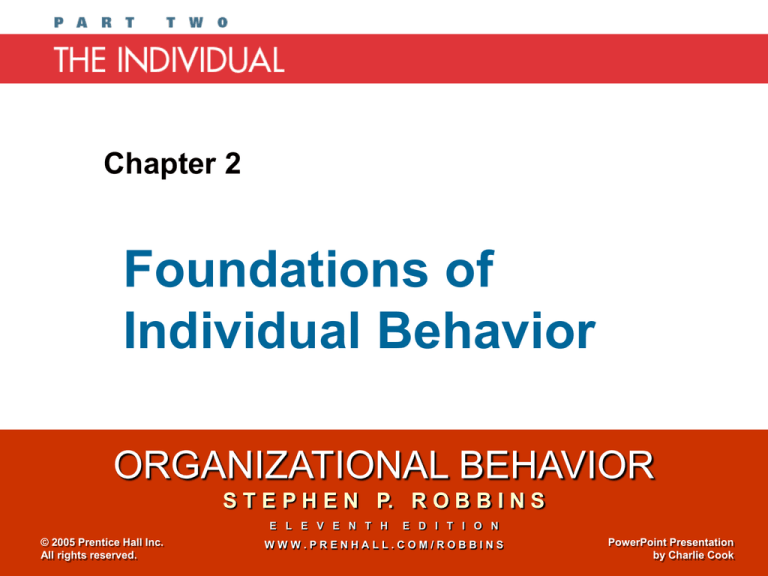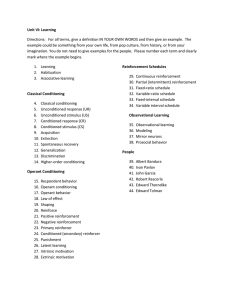
Chapter 2
Foundations of
Individual Behavior
ORGANIZATIONAL BEHAVIOR
S T E P H E N P. R O B B I N S
E L E V E N T H
© 2005 Prentice Hall Inc.
All rights reserved.
E D I T I O N
WWW.PRENHALL.COM/ROBBINS
PowerPoint Presentation
by Charlie Cook
Biographical Characteristics
Biographical Characteristics
Personal characteristics—such as age, gender, and
marital status—that are objective and easily obtained
from personnel records.
© 2005 Prentice Hall Inc. All rights reserved.
2–2
Ability, Intellect, and Intelligence
Ability
An individual’s capacity to perform the various tasks
in a job.
Intellectual Ability
The capacity to do mental activities.
Multiple Intelligences
Intelligence contains four subparts:
cognitive, social, emotional, and cultural.
© 2005 Prentice Hall Inc. All rights reserved.
2–3
Physical Abilities
Physical Abilities
The capacity to do tasks demanding stamina,
dexterity, strength, and similar characteristics.
© 2005 Prentice Hall Inc. All rights reserved.
2–4
Learning
Learning
Any relatively permanent change in behavior
that occurs as a result of experience.
Learning
• Involves change
• Is relatively permanent
• Is acquired through experience
© 2005 Prentice Hall Inc. All rights reserved.
2–5
Theories of Learning
Classical Conditioning
A type of conditioning in which an individual
responds to some stimulus that would not
ordinarily produce such a response.
Key Concepts
• Unconditioned stimulus
• Unconditioned response
• Conditioned stimulus
• Conditioned response
© 2005 Prentice Hall Inc. All rights reserved.
2–6
Theories of Learning (cont’d)
Operant Conditioning
A type of conditioning in which desired voluntary
behavior leads to a reward or prevents a punishment.
Key Concepts
• Reflexive (unlearned) behavior
• Conditioned (learned) behavior
• Reinforcement
© 2005 Prentice Hall Inc. All rights reserved.
2–7
Theories of Learning (cont’d)
Social-Learning Theory
People can learn through observation and direct
experience.
Key Concepts
• Attentional processes
• Retention processes
• Motor reproduction processes
• Reinforcement processes
© 2005 Prentice Hall Inc. All rights reserved.
2–8
Theories of Learning (cont’d)
Shaping Behavior
Systematically reinforcing each successive step that
moves an individual closer to the desired response.
Key Concepts
• Reinforcement is required to change behavior.
• Some rewards are more effective than others.
• The timing of reinforcement affects learning
speed and permanence.
© 2005 Prentice Hall Inc. All rights reserved.
2–9
Types of Reinforcement
Positive reinforcement
– Providing a reward for a desired behavior.
Negative reinforcement
– Removing an unpleasant consequence when the
desired behavior occurs.
Punishment
– Applying an undesirable condition to eliminate an
undesirable behavior.
Extinction
– Withholding reinforcement of a behavior to cause its
cessation.
© 2005 Prentice Hall Inc. All rights reserved.
2–10
Schedules of Reinforcement
Continuous Reinforcement
A desired behavior is reinforced each time it is
demonstrated.
Intermittent Reinforcement
A desired behavior is reinforced often enough to
make the behavior worth repeating but not every
time it is demonstrated.
© 2005 Prentice Hall Inc. All rights reserved.
2–11
Schedules of Reinforcement (cont’d)
Fixed-Interval Schedule
Rewards are spaced at uniform time intervals.
Variable-Interval Schedule
Rewards are initiated after a fixed or constant
number of responses.
© 2005 Prentice Hall Inc. All rights reserved.
2–12
Behavior Modification
OB Mod
The application of reinforcement concepts
to individuals in the work setting.
Five Step Problem-Solving Model
1. Identify critical behaviors
2. Develop baseline data
3. Identify behavioral consequences
4. Develop and apply intervention
5. Evaluate performance improvement
© 2005 Prentice Hall Inc. All rights reserved.
2–13
OB MOD Organizational Applications
Well Pay versus Sick Pay
– Reduces absenteeism by rewarding attendance, not
absence.
Employee Discipline
– The use of punishment can be counter-productive.
Developing Training Programs
– OB MOD methods improve training effectiveness.
Self-management
– Reduces the need for external management control.
© 2005 Prentice Hall Inc. All rights reserved.
2–14







